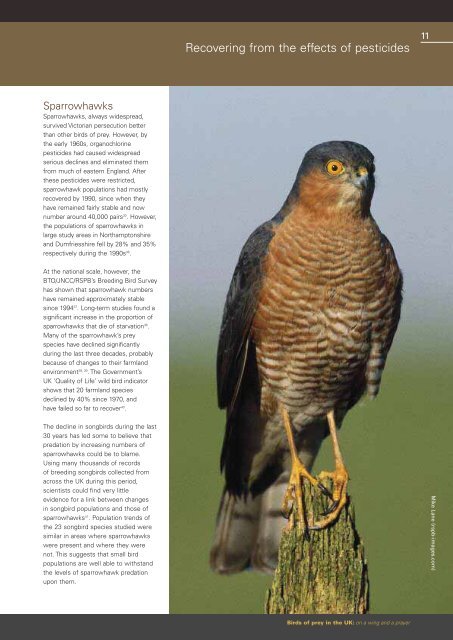BIRDS OF PREY IN THE UK - RSPB
BIRDS OF PREY IN THE UK - RSPB
BIRDS OF PREY IN THE UK - RSPB
Create successful ePaper yourself
Turn your PDF publications into a flip-book with our unique Google optimized e-Paper software.
Recovering from the effects of pesticides<br />
11<br />
Sparrowhawks<br />
Sparrowhawks, always widespread,<br />
survived Victorian persecution better<br />
than other birds of prey. However, by<br />
the early 1960s, organochlorine<br />
pesticides had caused widespread<br />
serious declines and eliminated them<br />
from much of eastern England. After<br />
these pesticides were restricted,<br />
sparrowhawk populations had mostly<br />
recovered by 1990, since when they<br />
have remained fairly stable and now<br />
number around 40,000 pairs 30 . However,<br />
the populations of sparrowhawks in<br />
large study areas in Northamptonshire<br />
and Dumfriesshire fell by 28% and 35%<br />
respectively during the 1990s 36 .<br />
At the national scale, however, the<br />
BTO/JNCC/<strong>RSPB</strong>’s Breeding Bird Survey<br />
has shown that sparrowhawk numbers<br />
have remained approximately stable<br />
since 1994 37 . Long-term studies found a<br />
significant increase in the proportion of<br />
sparrowhawks that die of starvation 36 .<br />
Many of the sparrowhawk’s prey<br />
species have declined significantly<br />
during the last three decades, probably<br />
because of changes to their farmland<br />
environment 38, 39 . The Government’s<br />
<strong>UK</strong> ‘Quality of Life’ wild bird indicator<br />
shows that 20 farmland species<br />
declined by 40% since 1970, and<br />
have failed so far to recover 40 .<br />
The decline in songbirds during the last<br />
30 years has led some to believe that<br />
predation by increasing numbers of<br />
sparrowhawks could be to blame.<br />
Using many thousands of records<br />
of breeding songbirds collected from<br />
across the <strong>UK</strong> during this period,<br />
scientists could find very little<br />
evidence for a link between changes<br />
in songbird populations and those of<br />
sparrowhawks 41 . Population trends of<br />
the 23 songbird species studied were<br />
similar in areas where sparrowhawks<br />
were present and where they were<br />
not. This suggests that small bird<br />
populations are well able to withstand<br />
the levels of sparrowhawk predation<br />
upon them.<br />
Mike Lane (rspb-images.com)<br />
Birds of prey in the <strong>UK</strong>: on a wing and a prayer

















